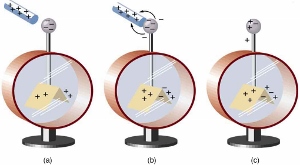Interactive and fun camps and clubs for children
Lesson III / 13 - Elektroskop
By building an electroscope, pupils will review concepts such as static electricity, an electric charge, and what is an electroscope – a detector of electrical charges.
Ask your children:
- What is electricity?
- Where can you find electricity?
- What is static static electricity?
- How is static electricity produced?
- Can you prove the presence of high voltage electricity?
- What is the name of the device which can show the presence of a high voltage electric charge
- Can you tell whether the electric charge is positive or negative?
An electroscope is an early scientific instrument that is used to detect the presence and magnitude of electric charge on a body. It was the first electrical measuring instrument.
The gold-leaf electroscope was developed in 1787 by British clergyman and physicist Abraham Bennet. It consists of a vertical metal rod, usually brass, from the end of which hang two parallel strips of thin flexible gold leaf. A disk or ball terminal is attached to the top of the rod, where the charge to be tested is applied. To protect the gold leaves from drafts of air they are enclosed in a glass bottle, usually open at the bottom and mounted over a conductive base. Often there are grounded metal plates or foil strips in the bottle flanking the gold leaves on either side. These are a safety measure; if an excessive charge is applied to the delicate gold leaves, they will touch the grounding plates and discharge before tearing. They also capture charge leaking through the air that could accumulate on the glass walls, and increase the sensitivity of the instrument. In precision instruments the inside of the bottle was occasionally evacuated, to prevent the charge on the terminal from leaking off through ionization of the air.
When the metal terminal is touched with a charged object, the gold leaves spread apart in a 'V'. This is because some of the charge on the object is conducted through the terminal and metal rod to the leaves. Since they receive the same sign charge they repel each other and thus diverge. If the terminal is grounded by touching it with a finger, the charge is transferred through the human body into the earth and the gold leaves close together.
The electroscope can also be charged without touching it to a charged object, by electrostatic induction. If a charged object is brought near the electroscope terminal, the leaves also diverge, because the electric field of the object causes the charges in the electroscope rod to separate. Charges of the opposite polarity to the charged object are attracted to the terminal, while charges with the same polarity are repelled to the leaves, causing them to spread. If the electroscope terminal is grounded while the charged object is nearby, by touching it momentarily with a finger, the same polarity charges in the leaves drain away to ground, leaving the electroscope with a net charge of opposite polarity to the object. The leaves close because the charge is all concentrated at the terminal end. When the charged object is moved away, the charge at the terminal spreads into the leaves, causing them to spread apart again.

The charge flowing into electroscope
Picture Demonstration with electrocsope - voer.edu.vn [CC-BY-3.0], via voer.edu.vn
If you are interested topic and want to learn more
Need help? Email us at info@vedanasbavi.cz



